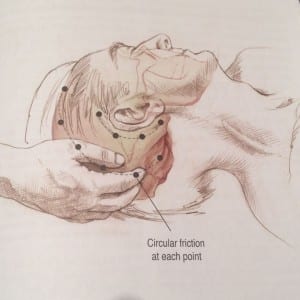 For years I’ve said deep massage of cranium is “like” working on the brain. Lately I’ve come to realize that, in important ways, it’s not “like” it, for practical purposes, it IS massaging the brain.
For years I’ve said deep massage of cranium is “like” working on the brain. Lately I’ve come to realize that, in important ways, it’s not “like” it, for practical purposes, it IS massaging the brain.
When you create an alternative focus other than thought, in the cranial region, almost inevitably thoughts turn down in volume or cease altogether. The mind can’t concentrate on two things at once (in spite of our pretense to “multi-task”).
So, with clear and enjoyable touch in its region, the mind focuses on the touch, pressure and pleasure, not on the thoughts in one’s head. So the cerebral, limbic, diencephalon, and autonomic nervous systems all go, at least temporarily, into an altered state.
Press in so that you’ve taken out the looseness in the cranial tissues. Visualize your touch as contacting the periosteum, not the skin or the hair (for this fulcrum creating the sound of hair on skin is counterproductive). Now traction the fascia semi-circularly. You may notice a restriction in the range of motion of the tissue. Or you may find places that are like cranial trigger points or remnants of past falls as a child that never got addressed. You can press into these and hold while the person lets go of tension from “inside out”.
I like to start at the mastoid process and lateral occiput. Then explore about four areas, each successively anterior around the ear. Then I explore about 6 more places starting near the base of the occiput but near the midline and working my way up to the top of the cranium and finally to where the forehead begins.
Thought acupressure? I like to affirm as I go that indeed the subjective experience of thought quiets or stops altogether. As long as we think the way we’ve usually thought we will re-create our world through that mind-set. Carlos Castaneda talked about the necessity of “stopping the world’ – Stopping the world is, he said “a technique by virtue of which the world as we know it is made to collapse.” I don’t want people’s world to collapse. But I do know that a regular vacation from our usual ways of thinking and feeling is a necessity for growth and learning.
So consider this a technique for stopping the world. When we stop going where we usually go and doing what we usually do, we have the possibility of choosing a new path. Hopefully, it will be one that supports our leading even healthier, happier lives, actualizing who we are through the application of care in touch with the soul, mind, body and heart.
